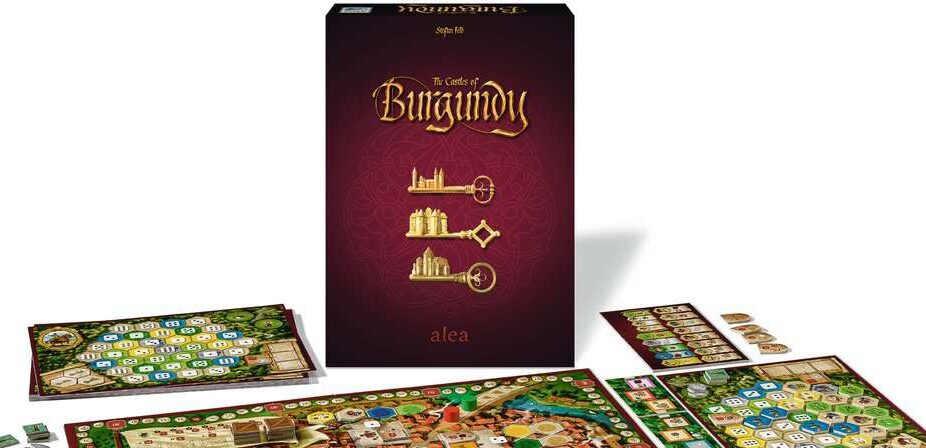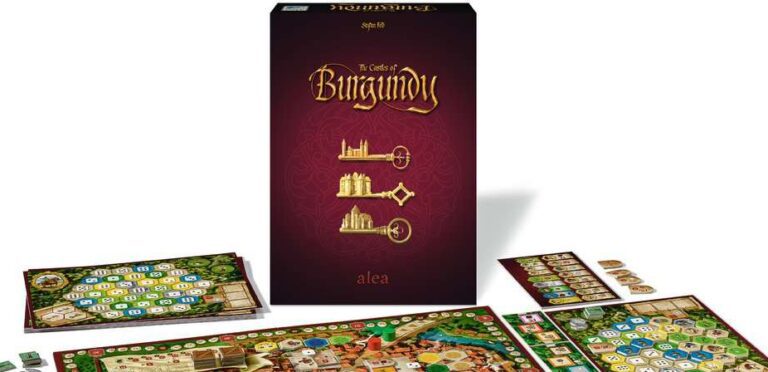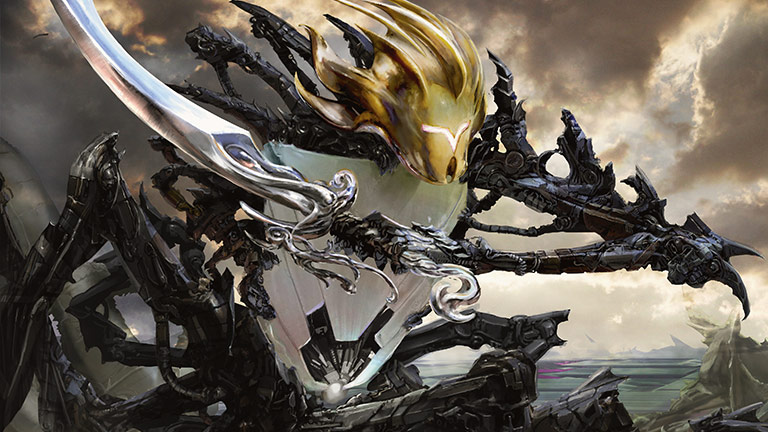Introduction to the review
A tabletop classic, The Castles of Burgundy is a game launched in 2011 where one to four players contend for the creation of the most prosperous princedom in the region.
Castles is a German-style title with simple-to-learn mechanics that still manages to be quite challenging in regards of optimization and sequencing.
The game contains plenty of combos and scenarios that make it highly replayable. According to its box one game of Castles lasts between seventy to a hundred and twenty minutes, although in a four-player format it can easily exceed this mark.
The age rating is set at twelve years old or above.
The subject of this particular review is the more common and improved Twentieth Anniversary edition published by Alea. While not a review of the ten-year-old original, they both remain similar.
The Anniversary edition includes all the released expansions to date encased within a small and elegant box. This is not just a “big box” edition of the game: the controversial art of the original Castles has been updated and a few balance and quality changes have been implemented.
What does The Castles of Burgundy include?
The first thing that will strike the eye of most players is the sheer amount of cardboard Castles comes with.
The game includes more than 300 tiles in between the base game and the expansions, on top of 24 coins, 24 worker tiles, 4 victory pieces, 8 playing pieces, a double-sided main board, 9 dice, 26 individual player territory boards and much, much more.
Castles also comes with a manual for several languages, including English, Spanish, Italian, French and German.
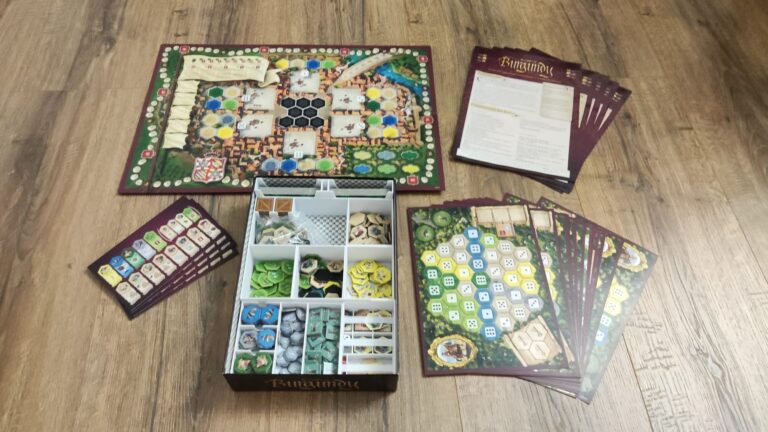

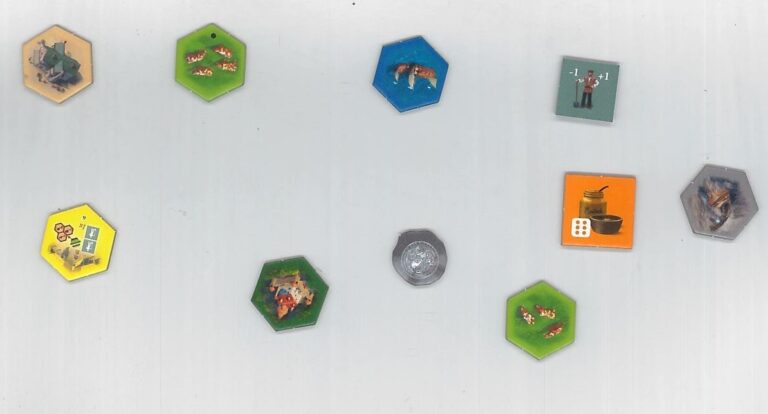

How do you play The Castles of Burgundy?
We highly recommend a thorough reading of the manual before beginning play. This section acts as a brief summary of the game dynamics, not a full explanation of them.
A game of Castles is comprised of 25 turns divided among 5 phases.
Every turn players roll two dice and each use their results in one of the following actions: bring a tile from the central board to the player´s personal reserve board, place a tile from the reserve board to the player´s territory, sell goods or buy workers which allow to change a roll with a ± 1 modifier.
Throughout the whole game players will be scoring victory points by means of commerce, livestock farming, construction and development; all depending on the type of tiles placed per turn.
With these tiles the players will be building their principality, earning points every time they completely seal off areas of the same color and also in relation to how fast they manage to do so.
There are six types of in-game tiles, each with different reserved spots inside the principality:
- Yellow tiles or monastery tiles provide an advantage for the rest of the game or add an additional way of scoring points when finishing, depending on the type (there are 26 monasteries).
- Blue tiles or ship tiles, which allow the player to get ahead in turn order and add goods to his/her deposit; these goods randomly accumulate in one of the six board regions until a blue tile is placed and the player takes all from one region.
- Green tiles or castle tiles, which are scarce and when played provide an extra action with any dice number of the player´s choice.
- Gray tiles or mine tiles, also scarce, which allow for the generation of coins at the end of each phase than can then be used by players to buy additional tiles in the black market.
- Light green tiles or livestock tiles, which add victory points based on the number of same type of animals contained in each pasture.
- And, lastly, beige tiles or building tiles, which contain up to eight different effects depending on their type; they include earning two coins, acquiring four workers, selling goods or getting an additional specific action.
At the end of the game the player with most victory points wins.
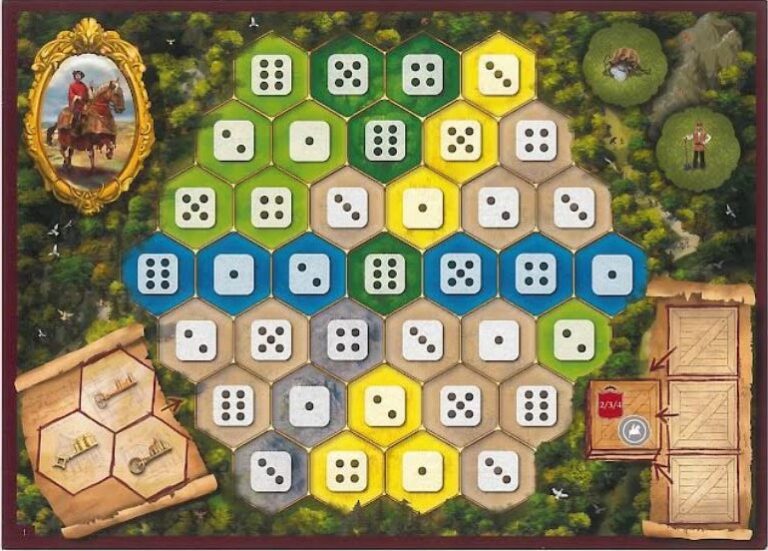

Play experience and strategies
The Castles of Burgundy is highly replayable and possesses multiple routes for players to approach it. Its 26 player boards and the random selection of tiles for each game both imply that participants will never meet the same scenario twice. Despite there being little direct interaction between players, decisions made by rivals may lead players to change their predefined strategy.
- In a four-player game Castles becomes more chaotic and unpredictable, but in a two-player one it is important to act according to what the rival does. Note that figuring out what the opponent wants to do and disrupting his intentions can at times be the best choice a player has.
- The scarcity of mine and castle tiles causes there to be a race in the early turns of each phase for them. A player fixated on getting them may want to acquire workers and advance his turn order before the end of a phase.
- Yellow ties or monastery tiles can completely change the way a player approaches a game; they can substantially ease the acquisition of certain main board tiles. Generally, these yellow tiles are very relevant in the early stages of a game and lose importance over in later rounds.
- Livestock tiles can easily generate you a lot of points, yet at the same time their tactical use is easy to counteract. In two-player games it is not difficult to either monopolize the use of one type of livestock animal or to mutually screw each other. The more participants, the more difficult it is for them to focus on the same kind of livestock. The problem with such kind of tiles resides in the fact that one can potentially lose a lot of points when deprived of the kind of animal they specifically want, and it is not worth it to finish a region that does not contain the same type. Players may consider focusing on livestock either for baiting a response or when they believe they can pursue it easily.
These strategic considerations in place, the completion of areas seems to be, if not the main priority, one of the main priorities in the game; especially in the early stages, when more points are earned for such actions.
- This is where tiles such as mines, which by themselves would not provide much added value in the beginning, deserve to be considered as relevant since they enclose areas quickly and allow for buying some of the best tiles from the black market later on.
- Sealing off areas of the same color gives extra points, even more so when being the first player to do so; thus it is important to plan the early game and not pursue tile placements in areas that the player is not confident will be able to be finished.
- It is important to note that players can only expand to adjacent regions where tiles are already placed. Because of player boards being different it is not always easy to finish mine or castle tiles. Players should take these ideas into consideration and set different strategic priorities depending on the map they get. It’s a good idea not to mix player board number 1 with the rest, as this one is geared towards first-timers (it is also a weaker board).
When it comes to weaker options, there too are some actions players should generally refrain from doing if they want to win.
- The most important play to avoid is to spend dice directly in the acquisition of two workers. Abusing this action will cost the player a few more down the road. No matter how much flexibility workers provide in the end it will not be worth it. Ideally it is better to not to pursue such action, acquiring workers instead through the placement of buildings.
- Another suboptimal action is to select a tile you personally have no interest in placing just because you strip an opponent from having it. In a four-player game this tactic should never be used. In a two-player game it may be different, as by depriving the rival you may sabotage him from earning more points than the ones you would get by taking another action. Although a hard skill to learn, players should try to count the amount of points earned by the opponent if they fulfill certain actions.
- Blue tiles or ship tiles are a double-edged sword; they do not provide a lot of points except for the ones that will come from eventually sealing off an area, yet they determine turn order, and therefore who gets to have more options at the start of a new turn. Player order is decided by advancing a colored piece across a small squared lane. There is a dilemma with advancing because the last player to do so in the lane is placed above the other colored pieces, meaning that the first player to place a ship in the present turn may not, in fact, be the first to start in the next one, potentially even being forced to see how the rest of players advance after him and effectively having two actions before the first player to advance has an opportunity for another.
- Ships carry another attractive quality for those that play them: goods. Accumulating the same type will overall make the action of selling much more efficient as more victory points are earned this way; it is therefore important to consider placing blue tiles to acquire certain goods from the market.
Final verdict
Not without good reason The Castles of Burgundy has become a staple in the board gaming scene; the fact that it still manages to maintain a top 15 spot in the BGG´s ranking list after more than a decade speaks volumes (and what a decade for tabletop it has been).
Castles is a title that rewards thoughtfulness and demands constant adaptability from the player every single turn.
Randomness with dice plays a substantial role, but the results from throws can be overcome due to the modifier effect of workers. As much as they may seem influenced by chance, games of Castles are usually close and get decided during small critical moments. In this regard the balance is quite surprising. Paired alongside its replay value and an affordable price, Castles of Burgundy is a good investment for any individual seeking to expand their board game library.
In regards of its replayability we have to highlight the Twentieth Anniversary edition comes with all expansions that were launched for the original game, with more city tiles, rewards for the sale of goods, new types of cattle, maps and components that enrich the overall experience.
In regards of duration, the first games will undoubtedly take longer due to the amount of things to learn and experiment with, and the time it takes to prepare all tiles between phases can get slightly annoying.
In order to solve this issue I printed a couple of small storage 3D components which help when it comes to setting up the game. Now playtime take around ten minutes less and the wait between phases is shorter, so you barely lose the pace. I recommend that the buyer acquire such components; they really keep things neat and tidy. You can find the ones I used by clicking here
With experience the games get shorter, and in a two-player format they can take less than an hour if both participants know what they are doing. With four, no matter how much players try to be fast, the game may get tedious for some.
Patiently waiting for others to weigh their options and choose two actions will leave participants staring at how the rest ruins their preferred choice. If we add the possibility of having turns where a participant starts first and ends the next one last then potentially there are time spans that feel exasperating.
Despite this, The Castles of Burgundy is a good game, particularly between two players; such format is without a doubt the best one and offers a very different experience when compared to three or four-player games.
Regardless of the number of participants, however, with the right gaming group a lot of enjoyment can be found.
All in all, for what the title itself offers, we conclude that The Castles of Burgundy is one that will not disappoint the tabletop enthusiast.
Also available in:





